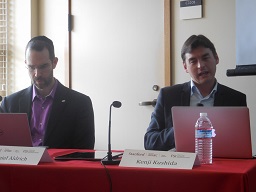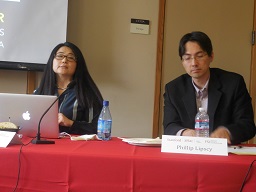Stanford Colloquium: Japan’s Great Earthquake & Nuclear Disaster: 5 Years Later [Report]
Japan’s Great Earthquake & Nuclear Disaster: 5 Years Later (March 10, 2016)
Japan Program Colloquium Series@Stanford University:
“The Great Tohoku Earthquake & Tsunami and Fukushima Nuclear Disaster: 5 Years Later”
Date/Time: March 10(Th), 12:00-1:30pm
Venue: Philippines Conference Room, Encina Hall, Stanford
Moderator:
Phillip LIPSCY, Assistant Professor of Political Science, Freeman Spogli Institute Center Fellow, APARC, Stanford University
Panelists:
Daniel ALDRICH, Professor of Political Science, Public Policy and Urban Affairs, and Co-Director of the Masters Program in Security and Resilience, Northeastern University
Kenji KUSHIDA, Research Associate, Japan Program, APARC, Stanford University.
Kyoko SATO, Associate Director, The Program in Science, Technology, and Society, Stanford University
Webpage: http://aparc.fsi.stanford.edu/japan/events/great-tohoku-earthquake-tsunami-and-fukushima-nuclear-disaster-5-years-later
Photo:
(From left) Dr. Aldrich, Dr. Kushida, Dr. Sato and Dr. Lipscy


Report:
Commemorating the Great East Japan Earthquake, Tsunami and Nuclear accident on March 11, 2011, this timely colloquium presented three speakers with very different attitudes and approaches toward the unprecedented disaster in Japan.
First, Dr. Daniel Aldrich gave a summary of his comprehensive study on differences in casualty rates as well as social recovery rates among towns and villages in the affected regions, and drew an important conclusion, that is, human connections or social capital made a significant difference in most of the cases.
Second, Dr. Kenji Kushida made a visual presentation about what was really happening in and around the Fukushima Daiichi nuclear power plant during and after the accident for the purpose of filling in some information gaps about the nuclear disaster and spelling out some misinformation that is still circulated and widely believed among the public.
Finally, Dr. Kyoko Sato tried to answer the question of why the Japanese who went through the nightmare of Hiroshima and Nagasaki, came to embrace nuclear power as an important source of energy for the nation, however reluctantly, in the postwar period, and applied various social-political models for possible explanations.
Although all these presentations were very interesting and informative, there remained quite a few questions to be asked, such as whether it is appropriate to use "crime rates" to be a proxy for the degree of human connections in Dr. Aldrich's study, whether how "socially," if not academically, significant it is to revise the timeline of the nuclear accident in detail 5 years later, as Dr. Kushida did, and whether we can ignore, as Dr. Sato did, the fact that many Japanese, at least most political and business leaders, were really concerned about the heavy reliance of imported oil and its security and environmental consequences to find any meaningful answer to her question.
It is too bad that there was not much time left for discussions after the three presentations within an hour and a half. Hopefully, some more Q&As will take place at a seminar about nuclear safety to be held on March 11 as a sequel to this colloquium: http://aparc.fsi.stanford.edu/events/learning-disaster-nuclear-safety-and-security-five-years-after-fukushima
(Takahiro Miyao)
----------------------------------------------------------------------
Japan Program Colloquium Series@Stanford University:
“The Great Tohoku Earthquake & Tsunami and Fukushima Nuclear Disaster: 5 Years Later”
Date/Time: March 10(Th), 12:00-1:30pm
Venue: Philippines Conference Room, Encina Hall, Stanford
Moderator:
Phillip LIPSCY, Assistant Professor of Political Science, Freeman Spogli Institute Center Fellow, APARC, Stanford University
Panelists:
Daniel ALDRICH, Professor of Political Science, Public Policy and Urban Affairs, and Co-Director of the Masters Program in Security and Resilience, Northeastern University
Kenji KUSHIDA, Research Associate, Japan Program, APARC, Stanford University.
Kyoko SATO, Associate Director, The Program in Science, Technology, and Society, Stanford University
Webpage: http://aparc.fsi.stanford.edu/japan/events/great-tohoku-earthquake-tsunami-and-fukushima-nuclear-disaster-5-years-later
Photo:
(From left) Dr. Aldrich, Dr. Kushida, Dr. Sato and Dr. Lipscy


Report:
Commemorating the Great East Japan Earthquake, Tsunami and Nuclear accident on March 11, 2011, this timely colloquium presented three speakers with very different attitudes and approaches toward the unprecedented disaster in Japan.
First, Dr. Daniel Aldrich gave a summary of his comprehensive study on differences in casualty rates as well as social recovery rates among towns and villages in the affected regions, and drew an important conclusion, that is, human connections or social capital made a significant difference in most of the cases.
Second, Dr. Kenji Kushida made a visual presentation about what was really happening in and around the Fukushima Daiichi nuclear power plant during and after the accident for the purpose of filling in some information gaps about the nuclear disaster and spelling out some misinformation that is still circulated and widely believed among the public.
Finally, Dr. Kyoko Sato tried to answer the question of why the Japanese who went through the nightmare of Hiroshima and Nagasaki, came to embrace nuclear power as an important source of energy for the nation, however reluctantly, in the postwar period, and applied various social-political models for possible explanations.
Although all these presentations were very interesting and informative, there remained quite a few questions to be asked, such as whether it is appropriate to use "crime rates" to be a proxy for the degree of human connections in Dr. Aldrich's study, whether how "socially," if not academically, significant it is to revise the timeline of the nuclear accident in detail 5 years later, as Dr. Kushida did, and whether we can ignore, as Dr. Sato did, the fact that many Japanese, at least most political and business leaders, were really concerned about the heavy reliance of imported oil and its security and environmental consequences to find any meaningful answer to her question.
It is too bad that there was not much time left for discussions after the three presentations within an hour and a half. Hopefully, some more Q&As will take place at a seminar about nuclear safety to be held on March 11 as a sequel to this colloquium: http://aparc.fsi.stanford.edu/events/learning-disaster-nuclear-safety-and-security-five-years-after-fukushima
(Takahiro Miyao)
----------------------------------------------------------------------



